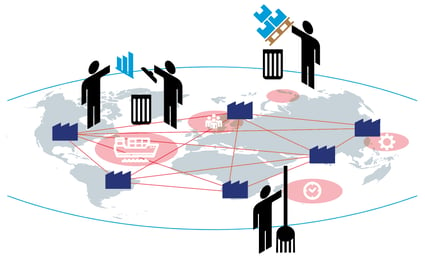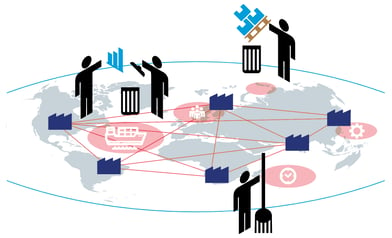Managing Disruptions in Times of Supply Chain Uncertainty
Brian Hoey - March 10, 2020

 As the Harvard Business Review points out, the 2011 Fukushima disaster had a large and unexpected impact on the global supply chain. While most large supply chain players didn’t expect their sourcing workflows to be impacted (based on the locations of their first tier suppliers), they quickly realized that a tremendous number of second and third tier suppliers were being hit hard by the incident. The result was that planners had to scramble to find new sources for raw materials, or risk shortages, outages, and late deliveries.
As the Harvard Business Review points out, the 2011 Fukushima disaster had a large and unexpected impact on the global supply chain. While most large supply chain players didn’t expect their sourcing workflows to be impacted (based on the locations of their first tier suppliers), they quickly realized that a tremendous number of second and third tier suppliers were being hit hard by the incident. The result was that planners had to scramble to find new sources for raw materials, or risk shortages, outages, and late deliveries.
Fast-forward almost a decade, and global manufacturers and other businesses are poised to face a similar problem—Costco, with many of its stores reporting SKU outages as people stock up an essentials amid COVID-19 concerns, reports that its supply chain is in disarray and could take weeks to stabilize. Though they report that production from impacted Chinese suppliers is beginning to ramp back up, Costco is still looking at a near-term struggle to keep goods on the shelves.
They’re certainly not the only ones; manufacturers of large products like automobiles tend to have diffuse global supply chains, and in times of crisis or uncertainty there’s always a possibility of significant disruption. The question is: how will your supply chain handle that disruption, and how can you get things back on track as quickly as possible?
Short-term: Optimizing Your Logistics Network
First things first: don’t panic. After you’re done not panicking, the first thing you need to consider is your ability to keep goods moving up and downstream in your supply chain as best as possible. In the face of something like a global pandemic or widespread work shortage, your usual shipping routes may be unavailable to you. You might even find that some of your shipments are already stuck in a port where they won’t be unloaded in timely fashion—whether that’s because of worker quarantines, a reduction in the work force, or simply large-scale backups due to confusion and disorganization. In instances like these, it pays to already know what your alternatives are:
- Are there other warehouses or inventory centers to which you could reroute shipments that are headed for impacted areas?
- Do you have enough buffer or safety stock to fulfill existing orders, while potentially earmarking delayed shipments for future orders once they’re on the move again?
- How effectively can you change your transport routes and tours once they’ve already begun, i.e. can you instruct a truck to reroute as new traffic information comes available?
If you can answer questions like these within your current IT environment, you’re in a position to manage short-term changes in the global supply chain without too much loss of value. That said, managing your logistics network in an agile, adaptable fashion is often easier said than done; it requires real-time tracking capabilities, end-to-end visibility via integration with your suppliers and logistics providers, plus advanced analytics that can help you analyze potential routes more quickly than a human planner with a spreadsheet could possibly do.
Mid-term: Demand Capacity Planning
Okay, let’s say you’ve rerouted your shipments, made creative use of your buffer stock and your network of warehouses, and you have a preliminary plan for meeting existing orders. What’s next? Figuring out how you’re going to continue to meet demand in light of potential supplier shortfalls and fluctuations in the market. Like Costco, you might be looking at a decent buffer stock to get you through the immediate future, but you may need to get creative with how you source your raw materials if your suppliers—or their suppliers—have been impacted by the global disruptions. This another area where end-to-end visibility is a must. Without it, there’s little hope of planning your way out of a jam.
In order to keep things on track in the middle distance, you need to match demand and production capacity in the way that you normally would—without counting on everything proceeding as normal. This means you may need to be flexible about production ratios and production plans in general, since you might have the parts on hand for a particular product while the raw materials for another product are delayed. In an instance like that, you’ll need a clear view of how production flows can be rearranged, which bills of materials are being impacted, and how you maximize capacity under unusual sourcing conditions. This is another area where advanced analytics can help you to visualize different production planning optimizations, keeping your production chain resilient in the same way your supply chain should be. To further bolster your resiliency, you should also take this opportunity to look at your sourcing workflows. If there are areas where you’re extremely reliant on a single source, this is a good time to figure that out and come up with a strategy for reducing the associated risks (e.g. creating arrangements with alternative suppliers so that you’re not totally beholden to an impacted business in a time of crisis).
Long-term: Keeping Sales and Operations Planning on Track
Now let’s zoom out to more strategic considerations: as you’re getting a hold of everything on the ground, you’re probably also trying to adjust your long-term goals and expectations for the aftermath of whatever supply chain crisis you happen to be working through. This is often a particular challenge, because it’s difficult to rely on existing forecasts and models to predict what things will be like in a month, three months, a year, or two years. For S&OP cycles, for instance, data and flexibility are the keys—you’ll want to significantly speed up your reporting cycles and give yourself the flexibility to tweak your plans on an ongoing basis.
As such, this is an ideal moment to consider implementing an S&OE (sales and operations execution) workflow to help keep your S&OP on track. S&OE is able to both make small adjustments to inventory and transport plans, while giving up-to-date supply chain snapshots to S&OP stakeholders. This can be especially crucial when things are volatile, because the typical response to short-term instability is often to overreact, and a dedicated S&OE team will make a point of avoiding any reactions that are counterproductively drastic. In this way, you build the foundations of a resilient supply chain—not just for the current crisis, but for future crises as well.
LATEST POSTS
- Understand Circular Economy in The Manufacturing Industry
- How Can Industry 4.0 IT Integration Be Achieved Smoothly?
- The Significance of Order Sequencing in Discrete Manufacturing
- How to improve your Supply Chain Management: The Power of Control Towers
- Optimizing Human Resource Scheduling in Manufacturing: A Technological Approach



